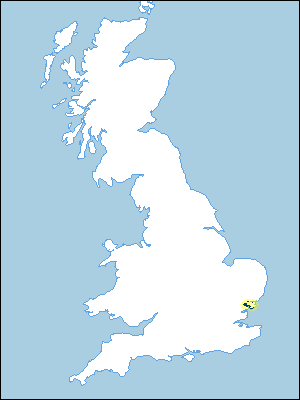
Soil Associations
0573b Wix
Soil and site characteristics
Deep permeable coarse loamy soils affected by groundwater. Associated with well drained sandy and coarse loamy soils and some slowly permeable seasonally waterlogged fine loamy over clayey and clayey soils giving patterned ground locally. Slight risk of water erosion.
Geology
Glaciofluvial drift over Eocene clay
Cropping and Land Use
Cereals, sugar beet and other arable crops; some grassland.
Component soil series
| Subgroup | Series name | Percentage | WRB 2006 link |
|---|---|---|---|
| 5.73 | WIX | 50% | Endogleyic Luvisols |
| 5.54 | EBSTREE | 10% | Arenic Chromic Luvisols |
| 5.71 | MAPLESTEAD | 10% | Haplic Luvisols |
| 7.11 | WICKHAM | 10% | Eutric Luvic Planosols |
| 5.73 | BREAMORE | 5% | Endoskeletic Gleyic Luvisols |
Covers 202 km2 in England and Wales
Soilscapes Classification
| 8 |
Slightly acid loamy and clayey soils with impeded drainage |
0573b Wix
Detailed Description
This association is mapped near Colchester where it covers 165 km² of gently and moderately sloping land between the low coastal plateau and lower ground bordering rivers or the sea. It is of varied composition and contains many soils. Most are formed on glaciofluvial drift over Eocene clay and the surface horizons often include some aeolian silty material. In many places the underlying clay impedes water flow and the soils are waterlogged for varied periods in winter. Coarse loamy Wix series and the closely related Breamore series, both gleyic argillic brown earths, are the most extensive soils but cover only about one-sixth of the area. These soils and the well-drained texturally-similar Maplestead series, typical argillic brown earths, occur mainly on the gentle upper slopes of valley sides. Outcrops of sandy drift, usually on convex slopes, carry well-drained Ebstree soils, typical argillic brown sands, having clay-enriched laminations in the deep subsoil; whilst there are wetter sandy Blackwood soils around springs and in hollows. Fine loamy or silty over clayey Wickham series, typical stagnogley soils, and occasionally Windsor series in London Clay occur on lower slopes, with Wigton Moor soilsin shallow dry valleys and on footslopes. These soils on lower ground are mostly waterlogged in winter. Although the soil pattern is complex the association is well defined by its landform and the associated soil and crop patterns which show on aerial photographs.
Soil Water Regime
Wix and Breamore soils are occasionally waterlogged (Wetness Class II); Wickham and Windsor soils with slowly permeable subsoils are waterlogged for longer periods (Wetness Class III). The response to drainage measures is variable. The permeable Wix and Breamore soils can be improved to Wetness Class I but Wickham and Windsor soils continue to suffer winter waterlogging (Wetness Class III). Ebstree and Maplestead series are permeable and naturally well-drained (Wetness Class I). Wix and Wickham soils are slightly droughty for cereals, oilseed rape and sugar beet, whereas Ebstree soils are moderately droughty for cereals and oilseed rape and very droughty for sugar beet. All soils are very droughty for potatoes and grass. Droughtiness in Breamore and Maplestead series is similar to that of Wix series. The differences in soil droughtiness are clearly seen on aerial photographs as patterns in growing crops. Thus in valley floors and on lower valley sides, dark tones correspond to good growth indicating the deep fine-textured Wigton Moor and Wickham soils. Deep coarse loamy soils show as dark-toned lines and polygonal patterns within the generally paler toned poorer growth of the droughty sandy or coarse loamy over gravelly soils of the upper slopes.
Cropping and Land Use
The Ebstree, Wix, Breamore and Maplestead series are easily worked and there are ample machinery work days even in a wet autumn. The heavier Wickham soils have a curtailed autumn working period. There are opportunities for spring working even in wet years, except on Wickham soils. Contrasting soils within a field, often make the timing of landwork difficult as sandy and coarse loamy soils are workable when heavier soils are too wet. Sugar beet harvesting in a wet autumn on the heavier soils frequently causes structural damage. Many of these soils have weak topsoil structures and slake easily, reducing rainwater infiltration into the soil. Erosion may then occur and occasionally gullies form. Winter cereals are the main crops, with some spring barley, sugar beet and potatoes, both second earlies and maincrop. There is a little rye grown on the sandy soils. Horticultural crops are grown locally especially around Thorrington, including vegetables and small and top fruit. Potatoes, sugar beet and horticultural crops need to be irrigated to produce good yields. All soils are naturally acid and require periodic liming. Generally, the phosphorus status is high in the sandy and coarse loamy soils, but potassium and magnesium levels are rather low. Boron is required for sugar beet. Soil variability within a field must be considered when fertilizers are applied.
0573b Wix
Distribution Map
 |
Note that the yellow shading represents a buffer to highlight the location of very small areas of the association.
Keys to component soil series
Eastern Region
 |
Typical Landscapes
Eastern Region
 |
All information Copyright, Cranfield University © 2024
Citation: To use information from this web resource in your work, please cite this as follows:
Cranfield University 2024. The Soils Guide. Available: www.landis.org.uk. Cranfield University, UK. Last accessed 26/04/2024
